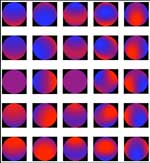 The analysis of stellar pulsations allowed a team composed of researchers from the Université de Montreal and the Université of Toulouse (France) to explore the interior of a star. This observation led to the discovery that stars undergo an important internal spin-down before they reach the white-dwarf stage, the last stage of evolution for Sun-like stars. The analysis of stellar pulsations allowed a team composed of researchers from the Université de Montreal and the Université of Toulouse (France) to explore the interior of a star. This observation led to the discovery that stars undergo an important internal spin-down before they reach the white-dwarf stage, the last stage of evolution for Sun-like stars.
 "Our study demonstrate that the internal spin-down of a star is a part of the evolution process toward the white-dwarf stage", explains Gilles Fontaine, professor at the Physics Department of the Université de Montreal and member of the CRAQ). "Our study demonstrate that the internal spin-down of a star is a part of the evolution process toward the white-dwarf stage", explains Gilles Fontaine, professor at the Physics Department of the Université de Montreal and member of the CRAQ).
In about 5 billions years, our Sun will evolve toward its terminal phase and will take the form of a white dwarf. This evolution is the fate of more than 95% of the stars in the Universe. White dwarfs are are the remnants of stellar cores. They are therefore very compact objets that weight about 60% of the total mass of our Sun but that are about the dimension of the Earth (i.e. about 1/100 of the Sun’s radius). In the process of becoming a white dwarf, the stars become inert and slowly cool down and dim off. If stars were to conserve forever the rotation motion created during their formation, then white dwarfs, because of their small size, would spin very fast with period of a few seconds. This is because of the principle of conservation of the angular momentum, which is also observed when a figure skater brings his arms closer to his body and starts spinning faster. However, in the observations, the surface of white dwarfs appears relatively still with observed rotation period of several hours, up to several years. The explanation could have be that a white dwarf hide its angular momentum in the inner shells, unreachable by direct observations.
The three researchers of the team showed that GW Virginis, a typical white dwarf in formation, is in slow rotation and that its structure is rigid over at least 90% of its radius, which encompass almost all of its mass (about 97%). This result excludes the possibility of a fast-rotating core. Furthermore, the period of rigid rotation of this star is estimated to 33.6 hours. The research team estimates that the residual rotational energy of GW Virginis corresponds to a mere 0.000001% of its internal thermal energy responsible for its luminosity. This implies that this star lost essentially all of its initial angular momentum during previous evolution phases. It suggests that the star, which is probably a descendant of a Sun-like star, has experienced an important spin down before becoming a white dwarf. This study therefore provides further support to the theories evoking the strong mechanisms of internal spin down of stars during their evolution, and excludes other theories.
The technique to obtain this result is called asterosismology. The stellar pulsations are used to probe the interior of stars, just like seismic waves on Earth are used to determine the internal structure of our planet. This method opens important perspectives to better understand the structural evolution and the dynamics of stars under the action of complex physical processes.
This discovery has been published in the prestigious journal Nature, on September 24th, 2009 (Charpinet, Fontaine and Brassard 2009, "Seismic evidence for the loss of stellar angular momentum before the white dwarf stage"). This research was supported by NSERC and the FQRNT. Gilles Fontaine also wnat to thanks the research Chair program of Canada.
http://www.nature.com/nature/journal/v461/n7263/abs/nature08307.html
Source :
Prof. Gilles Fontaine, Département de physique, Université de Montréal
tel: 514-343-6111-X47666; fax: 514-343-2071; email: fontaine@astro.umontreal.ca
Dr. Stéphane Charpinet, Laboratoire d’astrophysique de Toulouse-Tarbes, Université de Toulouse
tel: +33 (0) 5 61 33 29 51; email: stephane.charpinet@ast.obs-mip.fr
Informations :
Olivier Hernandez, Ph.D.
Press
CRAQ – Université de Montréal
Tel: 514-343-6111 ext 4681
Fax: 514-343-2071
olivier@astro.umontreal.ca
|

 The analysis of stellar pulsations allowed a team composed of researchers from the Université de Montreal and the Université of Toulouse (France) to explore the interior of a star. This observation led to the discovery that stars undergo an important internal spin-down before they reach the white-dwarf stage, the last stage of evolution for Sun-like stars.
The analysis of stellar pulsations allowed a team composed of researchers from the Université de Montreal and the Université of Toulouse (France) to explore the interior of a star. This observation led to the discovery that stars undergo an important internal spin-down before they reach the white-dwarf stage, the last stage of evolution for Sun-like stars. "Our study demonstrate that the internal spin-down of a star is a part of the evolution process toward the white-dwarf stage", explains Gilles Fontaine, professor at the Physics Department of the Université de Montreal and member of the CRAQ).
"Our study demonstrate that the internal spin-down of a star is a part of the evolution process toward the white-dwarf stage", explains Gilles Fontaine, professor at the Physics Department of the Université de Montreal and member of the CRAQ).